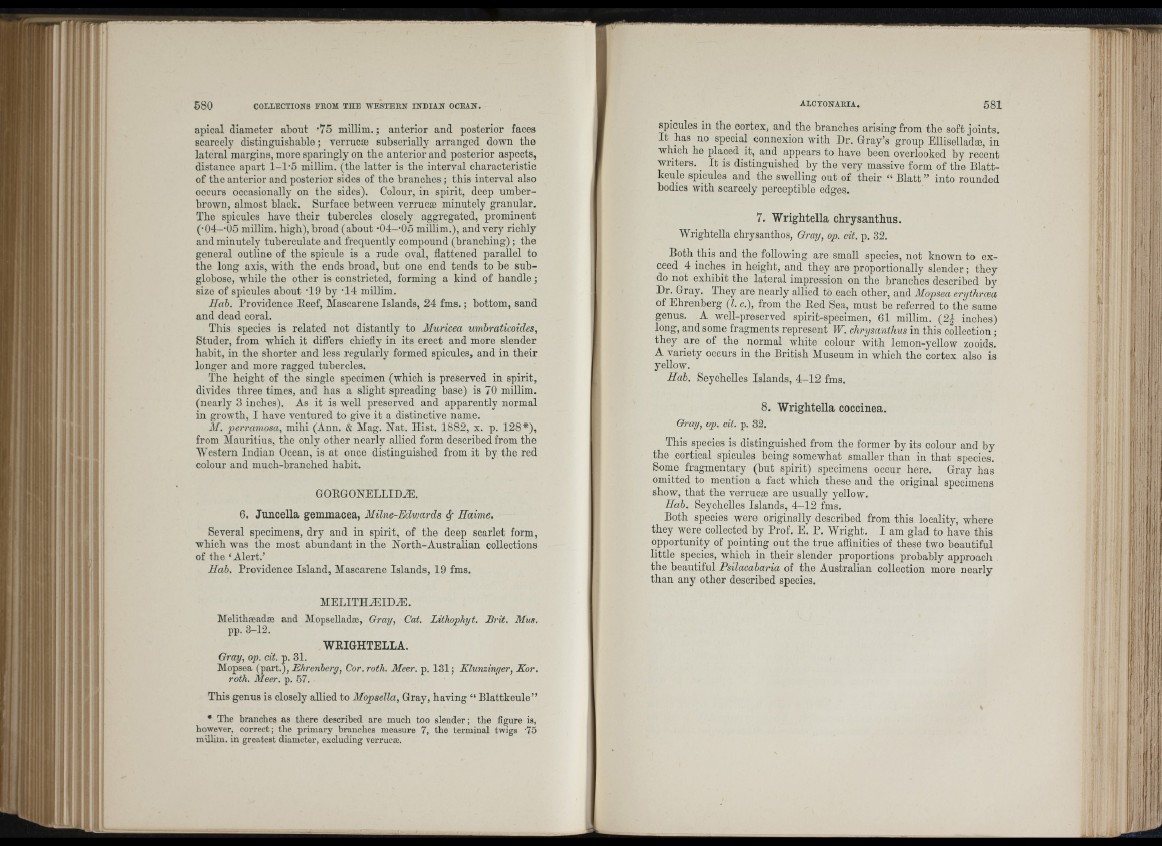
i l f I
l t ‘ * l
.M i l
i <
■ 1
apical diameter about ‘75 millim.; anterior and posterior faces
scarcely distinguishable; verrucæ subserially arranged down the
lateral margins, more sparingly on the anterior and posterior aspects,
distance apart 1-1-5 millim. (the latter is the interval characteristic
of the anterior and posterior sides of the branches ; this interval also
occurs occasionally on tbe sides). Colour, in spirit, deep umber-
brown, almost black. Surface between verrucæ minutely granular,
Tbe spicules bave their tubercles closely aggregated, prominent
(■04--05 millim. high), broad (about -Od-'OS millim.), and very richly
and minutely tuberculate aud frequently compound (branching) ; tbe
general outline of the spicule is a rude oval, flattened parallel to
the long axis, with the ends broad, but one end tends to be sub-
globose, while tbe otber is constricted, forming a kind of handle ;
size of spicules about -19 by -14 millim.
Hah. Providence Eeef, Mascarene Islands, 24 fms. ; bottom, sand
and dead coral.
This species is related not distantly to Aluricea umhraticoides,
Studer, from wbicb it differs chiefly in its erect and more slender
habit, in the shorter and less regularly formed spicules, aud in their
longer and more ragged tubercles.
The height of tbe single specimen (which is preserved in spirit,
divides three times, and bas a slight spreading base) is 70 millim.
(nearly 3 inches). As it is well preserved and apparently normal
in growth, I bave ventured to give it a distinctive name.
AI. qoerramosa, mibi (Ann. & Mag. Nat. Hist. 1882, x. p. 128*),
from Mauritius, tbe only other nearly allied form described from the
AVestern Indian Ocean, is at once distinguisbed from it by tbe red
colour and mucb-brancbed habit.
GOEGONELLIDEE.
6. Juncella gemmacea, Alilne-Edwards Sf Haime.
Several specimens, dry and in spirit, of tbe deep scarlet form,
wbicb was tbe most abundant in the North-Australian collections
of tbe ‘Alert.’
Hah. Providence Island, Mascarene Islands, 19 fms.
MELITHÆIDÆ.
Melithæadæ and Mopselladæ, Gray, Cat. Lithophyt. Brit. AIus.
pp. 3-12.
WEIGHTELLA.
Gray, op. cit. p. 31.
Mopsea (part.), Ehrenherg, Cor. roth. Aleer. p. 131 ; Klunzinger, Kor.
roth. Meer. p. 57.
Tbis genus is closely allied to Mopsella, Gray, having “ Blattkeule”
* The branches as there described are much too slender ; the figure is,
however, correct; the primary branches measure 7, the terminal twigs '75
millim. in greatest diameter, excluding verrucæ.
ì l i
spicules in the cortex, and the branches arising from the soft joints.
I t has no special connexion witb Dr. Gray’s group Elliselladæ, iu
which be placed it, and appears to bave been overlooked by recent
writers. _ I t is distinguisbed by tbe very massive form of tbe Blattkeule
spicules and tbe swelling out of tbeir “ Elatt ” into rounded
bodies witb scarcely perceptible edges.
7. Wrightella chrysanthus.
Wrightella cbrysantbos, Gray, op. cit. p. 32.
Botb this and the following are small species, uot known to exceed
4 inches in height, and they are proportionally slender ; they
do not exhibit the lateral impression on the branches described by
Dr. Gray. They are nearly allied to each otber, and Mopsea erythrcea
of Ehrenberg (I. c.), from the Bed Sea, must be referred to the same
genus. A well-preserved spirit-specimen, 61 millim. ( 2 | inches)
long, and some fragments represent W. chrysanthus in tbis collection ;
they are of the _ normal white colour witb lemon-yellow zooids.
A variety occurs in tbe British Museum iu which tbe cortex also is
yellow.
Hab. Seychelles Islands, 4 -1 2 fms,
8. Wrightella coccinea.
Gray, op. cit. p. 32.
This species is distinguisbed from tbe former by its colour and by
tbo cortical spicules being somewhat smaller than in th at species.
Some fragmentary (but spirit) specimens occur here. Gray bas
omitted to mention a fact which these and tbe original specimens
show, that tbe verrucæ are usually yellow.
Hah. Seychelles Islands, 4 -1 2 fms.
Botb species were originally described from this locality, where
they were collected by Prof. E. P. AVrigbt. I am glad to have tbis
opportunity of pointing out the true affinities of these two beautiful
little species, wbicb in tbeir slender proportions probably approach
the beautiful Psilacabaria of the Australian collection more nearly
than any otber described species.
I hi.
I î:î!!:il
UI '■
'fi! ■
■r ;i ; '
'J
.. ^ M,
Nl